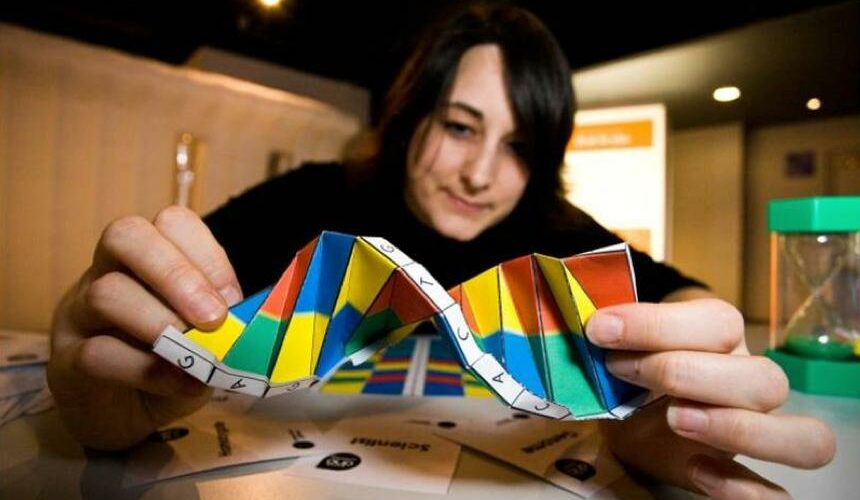The fault in our genes

Humans are one of the most cognitively complex and advanced form of organisms. Nonetheless, like any other being they are made up of cells. There are 70 trillion of these cells working together tirelessly to make us who we are. Much like an operating system, each of these cells has a template called the genome where all the information is written. This information is written in the form of four letter codes made up of the letters A, T, G and C, with a total of 3 billion of these letters making your DNA. A set combination of these codes make up the genes, which is read and processed into RNA. These RNA are then analyzed and read in triplets giving rise to the final product, which is proteins. All cells follow the central dogma of life: the flow of genetic information from genes DNA to RNA and ultimately to protein. Each cell contains DNA that is up to two metres long. These enormous strands are compacted into structures called chromosomes, of which humans have 23 pairs.
Altering the sequence of A, T, G, C codes can either have no consequence, or may affect the entire machinery of life. These changes, called variations, are the root cause for the enormous database of genetic disorders. Everything has its roots in genetic variation, from things like baldness, skin colour, music preference, and sexual orientation, to depression, schizophrenia, intellectual disability, miscarriage, muscular dystrophy and cancer. All humans share 99.9% of their DNA, and it is that 0.01% variation which makes each of us a unique creature, with a unique mind and body.

The famous DNA double helix and how it is compacted to make chromosomes – 46 in human cells. Illustration from Anatomy & Physiology via wikimedia (CC BY 3.0)
Here are four out of the thousands of fascinating genetic disorders that affect people worldwide:
1. Physically a girl, but genetically a guy: Androgen Insensitivity Syndrome (AIS)
In this disorder, the affected person is genetically a male. However, they look, feel, and have all the physical features of a woman. It is caused by a variation in a gene which makes a person resistant to male hormones (androgens). During development in the womb, all of us are initially programmed to develop into a female body, and the presence of the male hormones in a genetically male fetus changes this, thereby producing an individual with the physical traits that of a male. An individual affected with AIS will have cells resistant to those hormones. Thus, during embryo development, they will continue developing as a female, despite having template to create a male.
2. When a 2 year old child suddenly forgets how to speak or use their hands: Rett Syndrome
Rett Syndrome typically affects girls, as boys who inherit this condition do not survive. It mostly occurs because of a spontaneous variation, and each child of an affected person has a 50% chance of inheriting it. This is a condition which manifests in children aged between 6-18 months, and sufferers will have it for life. As of yet, there is no cure. The disease is caused by a variation in a gene leading to the impairment of brain development. The child’s deliberate use of her hands is taken over by uncontrollable repeated wringing, washing, or clapping movements. She progressively loses the ability to hold, manipulate, or do any work or deliberate action with her hands. As she grows, she loses the ability to communicate, socialize, or use any language, and is affected with intellectual disability. Those affected have a normal lifespan but need life-long support. This disorder affects 1 in 8500 females, and shouldn’t be confused with autism or Down syndrome.
3. And then he turned into a stone: Stone Man Syndrome
In this disorder (which is also called Fibrodysplasia Ossificans Progressiva), the muscles and other connective tissues are affected, and are slowly turned into bones. It is seen mainly in children. Normally, the body converts cartilages into bone through a process called “ossification”. A variation in a gene crucial to the process of ossification leads to this process being constantly turned on, leading to the uncontrolled conversion of the muscles, ligaments and joints into bone.
As those affected have their muscles and cartilages replaced by bones gradually, they become unable to open their mouth, or move their joints as they becomes rigid. Ultimately, are unable to breathe. Any injury exaggerates this process even further. This disorder is very rare, with 1 in 2 million people affected; most survive up to the age of 40.
4. There was a boy who couldn’t sweat: Hypohidrotic Ectodermal Dysplasia
In this disorder, the sufferer lacks sweat glands, hair follicles, and often teeth. This is caused by a variation in the gene which is responsible for the interaction of the germ layers that gives rise to all your organs in the embryo. When the outer layer fails to interact with the middle one, no skin appendages like hair follicles, teeth and sweat glands are formed.
The affected can have a prominent forehead, with small sharp and spare teeth, or no teeth at all. They have dark, rough skin around their eyes, and have no or sparse hair. The the absence of sweat glands is what proves to be most detrimental: their body cannot cool itself, hence they suffer from very high fever during mild illness, and need to be in a temperature controlled environment all the time. Any activity, like running or exercise, which heats up the body can prove to be fatal as there is no way to release the body heat. It is always advised that sufferers stay indoors, and during warm conditions, wear wet clothes to maintain the body temperature! This disorder affects 1 in 17000 people worldwide.
These were just four of the varied genetic disorders that affect people from all over the world, and they do not have any conventional cure. Although, with medical aid, which is usually very expensive, some of the symptoms can be made more bearable. A lot of progress has been made in the field of gene therapy and precision medicine, with newer processes like genome editing making promising developments.
Living a life with a genetic disorder isn’t easy, and sufferers can find themselves outcast from society. Nature is weird and it is our DNA that plays God: one alteration in the 3 billion code of life can change everything. Such is the enormity of the number of genetic disorders, that funds and resources to study and find a cure are not available for all the disorders. Only a few are studied, with scientists all around the world striving to find a cure for common genetic disorders like Down syndrome, autism, Huntington’s disease, Duchenne muscular dystrophy, cystic fibrosis and too many more to list.
It is vital that everyone knows about the importance of genetics: how it can affect any single one of us spontaneously, because nature doesn’t discriminate. Many scientists and kin of the affected live in the hope that sometimes, instead of all the celebrity buzz, focus will be on these real-life stars battling with a genetic disorder; and more organizations will come forward funding the research on these innumerable genetic disorders. Right now, financial constraints serve as the major limitation into the research and development of diagnostic techniques and treatments. The reality is for many of these diseases, even the cause isn’t known.
This article was specialist edited by Bhoomi Gor and copy edited by Rebecca Baird.
For more in depth information about the genome, genes, variations, and all the genetic disorders, their diagnosis and management, the following websites are recommended:
- Genetic Home Refernce; ghr.nlm.nih.gov
- Gene Reviews; ncbi.nlm.nih.gov/books/NBK1116
- OMIM : Online Mendelian Inheritance in Man; ncbi.nlm.nih.gov/omim










